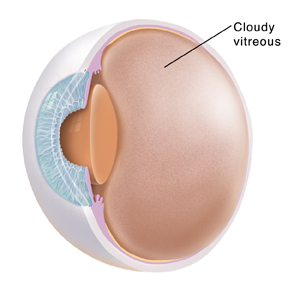Diabetic Retinopathy: Having a Vitrectomy
Diabetic Retinopathy: Having a Vitrectomy
You have diabetic retinopathy. This condition happens when diabetes damages blood vessels in the back of the eye. It can cause cloudy vision and other problems. But a type of surgery called vitrectomy may help you see more clearly.
What is vitrectomy?
When healthy, the gel (vitreous) that fills the eye is clear. But with diabetic retinopathy, this gel can become clouded with blood or debris. During vitrectomy, the eye healthcare provider removes the cloudy vitreous. It is replaced with fluid, silicone oil, or gas. The retina may also be repaired if there is scar tissue. This can help make your vision clearer. But if you still have vision problems after vitrectomy, more surgery may be needed. A successful vitrectomy may make it possible to do other procedures to restore vision. These include laser treatments.
Preparing for the surgery
Tell your healthcare provider about all medicines, vitamins, herbal remedies, and supplements you take. This includes over-the-counter and prescription medicines. It includes aspirin, ibuprofen, ginkgo, warfarin, or other blood thinners. Before surgery, you will meet with a healthcare provider (anesthesiologist) who provides medicine to control pain. You’ll talk about the type of pain medicine (anesthesia) you will have during the surgery.
During the surgery
During the surgery, tiny tools are inserted through small cuts (incisions) in the white of the eye (the sclera). The vitreous is removed. It is replaced with a substitute, such as saltwater (saline) solution, silicone oil, or a gas bubble that holds the retina in place. The surgery may take a few hours.
Following the surgery
Be sure to have an adult family member or friend drive you home after the surgery. Wear dark sunglasses on the way home. Before leaving, you’ll be told how to protect and care for your eye. Don’t rub, touch, or bump your eye. Ask your healthcare provider how long you need to wait before you can lift things, exercise, or swim. Also ask when you can drive and go back to work.
Controlling pain
Vitrectomy may cause some pain. You’ll be given medicine to control this pain. If discomfort continues, tell your healthcare provider.
Risks and complications of vitrectomy
Risks and possible complications include the following:
Swollen or droopy eyelid
Double or blurry vision
Retinal detachment
Bloody sclera
Watery or red discharge
Pain
Cloudiness in lens of the eye (cataract)
Vision doesn't get better
When to call your healthcare provider
After you go home, call your healthcare provider right away if:
You have increasing pain
You have vision problems after the eye patch is removed
Updated:
June 09, 2017
Sources:
Diabetic retinopathy: Prevention and treatment. UpToDate, Retinal Detachment. UpToDate
Reviewed By:
Brown, Kim, APRN,Hurd, Robert, MD,Image reviewed by StayWell medical illustration team.
